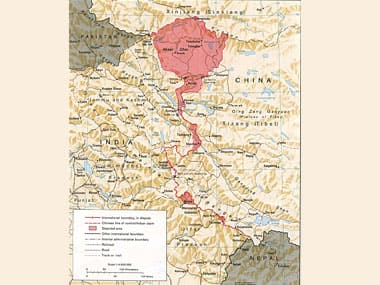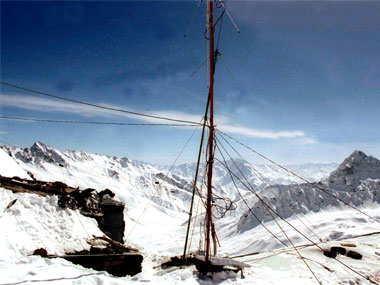Yarkandi caravan guides on the great Himal’s routes to Leh, might have mapped the journey thus: from the great plains, climb into the pass of the black gravel, the Karakoram. From there, cross the Chip-Chap, the very quiet river, to reach Daulat Beg Oldi, the spot where the great and rich man died,. Then, you reach a long open space, the Depsang plateau, leading on to the Qazi Langar, a qazi, or cleric once ran a kitchen. Then comes the camp at Burtsé, named for shrubs that can heal wounds, and burn well. Now, ahead, lies the Mur-go, the gate to hell. Earlier this summer, a platoon of People’s Liberation Army made the journey so evocatively described by the great mountaineer Harish Kapadia, planting itself in abandoned Indian army huts. Indian army sources say this isn’t the first time Chinese patrols have entered the area—but they have never held a position like this before. Flag meetings have been called to resolve the issue, but India has also positioned troops some 500 metres away. Does the gate to hell lie ahead? For years now, Indian military strategists have worried about just such an outcome. Fears of growing Chinese nationalism, backed by military might, have grown on the back of China’s increasingly muscular posture on its eastern seaboard. Back in 2008, Defence Minister AK Anthony is believed to have issued a formal directive calling on the armed forces to prepare for a two-front war. In 2010, former Army Chief Deepak Kapoor publicly spoke of preparing for a two-front war. Mulayam Singh Yadav, India’s former Defence Minister, even told Parliament in November 2011 that he had evidence China was “going to attack us soon”. [caption id=“attachment_721573” align=“alignleft” width=“380”]  The Siachen sector, next to Daulat Beg Oldi, in India. Praveen Swami/ Firstpost[/caption] India has responded, the defence expert Ajai Shukla notes, by significantly enhancing its offensive resources—notably, by committing to set up an entire new mountain strike corps. Its built a string of forward airstrips in the region, including one at Daulat Beg Oldi, allowing for troops to be moved quickly. Last March, though, a leaked letter by former army chief General VK Singh warning of “hollowness” in Indian defences provoked anxieties about whether India was ready for the emerging threat. The facts behind these fears are simple. China’s declared military budget for this year is $117 billion, up from $106.4 billion in 2012-2013 and $91.5 billion in 2011-12. For the past decade, China’s military budget has expanded at about 12%, ahead of its economic growth. The country expanding its cruise and ballistic missile arsenal; the new Dong Feng-21D, comes with a manoeuvrable warhead that constitutes the first serious threat to United States carriers supremacy in the Pacific. It has rolled out a prototype for a fifth-generation stealth fighter and inducted an aircraft carrier. Fearsome as China’s military build-up might be, though, it isn’t clear if Indians need to be terrified. Eight of China’s 18 Group Armies—the equivalent, roughly, of an Indian corps—face out on its south-eastern seaboard. Throughout China’s military modernisation drive, the United States defence department has noted in its 2012 report, “Taiwan contingency planning has dominated the agenda”. “Even though cross-Strait tensions have subsided since 2008, Taiwan remains a critical mission, and the PLA continues building capabilities aimed at Taiwan and at deterring, delaying, or denying possible third party intervention in a cross-Strait conflict”. Taiwan isn’t, moreover, China’s only military concern. In the Koreas, the PLA must plan for possible war; in Xinjiang and Tibet for insurgencies; on the high seas, for control of trade routes and oil. Last year, in a talk delivered around the same time Yadav was holding out his prediction of imminent assault, the scholar Kanti Bajpai offered several sound military reasons why the risks of war with China are low. He pointed to the difficulties in destroying India’s Air Force, necessary to secure China’s logistics; the robust defensive positions occupied by India’s Army in the Himalayas; the limited capabilities of the PLA navy to wage a campaign in the Indian Ocean. Bajpai concluded by asserting that “war between the two countries is not very likely unless one or the other engages in highly provocative, ill-judged behaviour—and even then, with nuclear weapons and air power, it would be very risky to go to war”. Events in Daulat Beg Oldi, though, are leading China sceptics to argue that its behaviour exactly that: ill-judged and highly-provocative. The foundational cause of the 1962 war, the Burtsé incident shows, persists: the fact that India and China cannot agree on their frontiers. The two countries, the scholar Wahegurupal Singh Sidhu notes never even demarcated the Line of Actual control after the ceasefire agreement of November 21, 1962—which means there is “disagreement on both sides as to the precise location of the LAC in many areas”. Brigadier John Dalvi’s must-read book on the causes of the 1962 war, as well as the assessments of experts like AG Noorani, show prime minister Jawaharlal Nehru’s ill-conceived policies on the border led India into a crisis it wasn’t prepared for—but still has to live with. The last round of India-China, in December 2012, ended with excellent atmospherics—but there’s been little forward movement. In essence, China has refused to bargain territory it holds in Aksai Chin, on the northern reaches of the LAC, while India will make no concessions on Arunachal Pradesh, to its east. China refuses to accept the LAC as a border, and thus has every interest in keeping it unsettled with low-grade incursions—or, from its point of view, demonstrations of presence in territory it claims to be its own. There have, by some estimates, been over 500 of these—though none, it bears mention, have ended in actual shooting. In a thoughtful commentary, Singapore-based scholar PS Surayanarayana observed that “enter into a border settlement when both recognise that the cost of not settling the issue outweighs the cost of a continuation of stalemate”—which, put another way, is no time soon. [caption id=“attachment_721575” align=“alignright” width=“380”]  India’s eastern border with China[/caption] For both countries, there are excellent reasons to avoid a crisis: a burgeoning trade relationship, multiple crisis with other neighbours, and, above all, the absence of any dividend from war. Yet, neither is willing to pay the political costs that will come with territorial compromise. The problem with simmering conflicts is that they can only too easily burst into full-blown ones: nations can’t always rely on the wisdom of politicians to avert crisis. In 1986, China moved troops into Sumdorong Chu, facing Tawang—the site of one of India’s worst defeats in the war. Then army chief General Krishnaswami Sundarji flew in an entire brigade north of Tawang, leading to a build-up and belligerent language. Rajiv Gandhi’s advisors blamed Sundarji for precipitating a crisis—leading the army chief to suggest the prime minister to “please make alternate arrangements if you think you are not getting adequate professional advice”. Sundarji’s resolve paid off—and the crisis petered off. India’s now done the same thing in Burtsé, though on a much smaller scale. The odds are this face-off will end peacefully, but we can’t work on the assumption the outcomes of future confrontations will have a happy ending. In 1928, the colonial explorer F Ludlow travelled down the Karakoram towards Daulat Beg Oldi. Ludlow’s map told him of a camp where three huts were available. “It did”, he wrote. And when I arrived, I found them all occupied — one by a dead pony, the second by a dead donkey, and the third by a dead Yarkandi”. Further ahead “a pile of stones and mud had been erected against the face of a cliff to form a shelter from the wind. I looked inside this shelter and found it contained three skulls and other gruesome human remains”.
That, we can only hope, doesn’t turn out to be a vision of the future as well.


)

)
)
)
)
)
)
)
)



